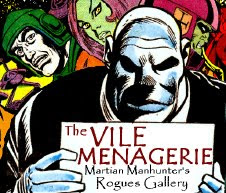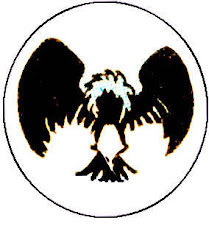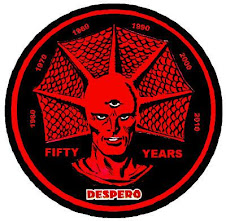
Tom Hartley's titanic final 1980s installment of the counterfeit Martian Manhunter Archive Editions is upon us! Download it in PDF format here!
Take me down——to the river of dreams . . .
Take me up——to the mountains of passion . . .
Take
me
home?
You probably think I’m repeating the
attention-getting gimmick from the previous
volume’s Foreword, quoting the lyrics of some
wacked-out ‘70s pop tune, but the above is
actually the complete text of the opening
page of this volume’s first story. In seven
volumes we’ve come a distance almost as
great as between Earth and Mars, from a six page
remake of The Day the Earth Stood Still
with Sam Spade as the Martian savior, to a
hundred-page fever dream with a theme song
by John Denver on acid. And most of that
distance was traveled in between the last
volume and this one.
At the end of THE MARTIAN
MANHUNTER ARCHIVES Vol. 6 it appears
we have come full circle——not without some
lengthy digressions, but still pretty much back
to where we began, with J’Onn J’Onzz the
Martian exile fighting evil on his adopted
Earth. In JUSTICE LEAGUE OF AMERICA
#230, the last issue reprinted in that volume,
he is welcomed home by his super-hero
comrades. He officially rejoins the League in
JUSTICE LEAGUE OF AMERICA ANNUAL
#2. A few months later he even resumes his
human John Jones identity.
But this is not the same League he had left
years ago. The team was originally conceived
as an updated version of the Justice Society of
America from comics’ Golden Age. Just as the
JSA united DC’s greatest heroes of the 1940s,
the mightiest heroes of the modern era joined
forces as the JLA. Over the years the
League’s ranks expanded from the seven
founding members——Superman, Batman,
Wonder Woman, Flash, Green Lantern,
Aquaman and our own J’Onn J’Onzz, the
Martian Manhunter——to over twice that
number. Most menaces were not significant
enough require the entire membership. In a
typical story less than half the membership
would appear. This meant that no individual
member had to commit to the team full-time.
This arrangement worked well enough for the
first 200 or so issues, especially since either
Superman or Batman, or often both, found the
time to participate in most adventures.
Wonder Woman, Flash and Green Lantern
were also frequent participants. You would
think that the more powerful, and more
popular, a super-hero was, the more demands
would be made of his or her time, and the
less time he or she would have for the
League. But fortunately, the opposite was
true, and in every issue readers could count
on appearances by two or more of the “big
five”. That is, until “The War of the
Worlds——1984!” When the League had to
defeat a Martian invasion of the planet Earth
without help from any of the “big five”,
current team-leader Aquaman decided some
changes were in order. From now on, each
member would have to commit to the League
full-time, resulting in a smaller, but more
dedicated membership. From the old League
Aquaman would be joined by Zatanna,
Elongated Man, and the returning Martian
Manhunter, and to this new League four new
members would be added——Vixen,
Commander Steel, Gypsy and Vibe. For the
first time in the long history of JUSTICE
LEAGUE OF AMERICA, the book’s concept
would be redefined. Instead of a banding
together of The World’s Greatest Super-
Heroes™ (a phrase trademarked by DC), the
JLA would now be four veteran super-heroes
mentoring four promising newbies. Of the
many revamps and relaunches the League
would endure over the next quarter of a
century, “Justice League Detroit” (so
nicknamed by readers because the team
moved its headquarters to the “Motor City”)
is still considered the least successful. After
two and a half years of declining sales, “JLD”
was forced to disband when Vibe and
Commander Steel were murdered by old JLA
foe, Professor Ivo. Gypsy retired from superheroing
and Vixen went on to join a more
popular group, the Suicide Squad. DC went
so far as to cancel the original series and
relaunch it with a new first issue, a slightly
different title, and, of course, a new
membership. JUSTICE LEAGUE OF AMERICA
#261 was followed the next month by
JUSTICE LEAGUE #1 (which would become
JUSTICE LEAGUE INTERNATIONAL with issue
#7).
The new team’s membership was
determined not by co-writers Keith Giffen and
J. M. DeMatteis, or by editor Andy Helfer,
but by folks higher up in DC’s management.
Once again veterans would join forces with
newbies. DC hoped that new characters Guy
Gardner and Dr. Light, along with recently
revamped versions of Golden Age greats,
Captain Marvel and Dr. Fate, and the Blue
Beetle, a Silver Age character DC had
recently acquired from another publisher,
would be the stars of tomorrow, and that
veterans Black Canary, Mister Miracle and
the Martian Manhunter would finally achieve
the stardom that eluded them for so many
years. And then you had Batman as the lossleader.
This second relaunch proved to be
more successful than the first one. It spawned
its share of spin-offs, including the four-issue
mini-series, MARTIAN MANHUNTER.
But all of this background still doesn’t
prepare us for what JUSTICE LEAGUE
INTERNATIONAL co-writer J. M. DeMatteis
did to our hero, so bear with me as I still have
some more ‘splainin’ to do.
In the mid-1980s the Justice League
wasn’t the only DC property that needed
fixing. The task of fixing the three biggest
stars, Superman, Batman and Wonder
Woman, went to the three most popular
creators of the day, John Byrne, Frank Miller
and George Perez. Byrne chose to streamline
the Man of Steel’s mythos, which had gotten
hopelessly complicated over the decades.
Gone were the various spin-off characters,
including Superboy, Supergirl, Krypto the
Super-Dog, Comet the Super-Horse, Beppo
the Super-Monkey, and the microscopic
populace of the Bottled City of Kandor,
leaving Kal-El the last son of Krypton and the
only bearer of the big red “S”. Frank Miller’s
fearsome, revenge-driven Dark Knight had
nothing in common with Adam West’s campy
TV crimefighter, or the goofy sci-fi hero of the
late 1950s and early 1960s, or any of the
other incarnations of Batman that had strayed
from Bob Kane and Bill Finger’s original
conception. And George Perez strengthened
the Amazon Princess’ connections to Greek
mythology, opening up interesting story
possibilities neglected by previous writers.
In the wake of these successful revamps,
many more DC characters were given new
origin stories, new costumes, completely new
identities, or in some other way had their lives
turned topsy-turvy, in the hopes that they, too,
would win new fans. Not every “bold new
direction” or attempt to show that “you only
thought you knew him” was a success, but
they certainly gave readers a lot to talk
about. It was an interesting, and sometimes
frustrating, time to be a comics fan.
At this point the Martian Manhunter had
been around for more than three decades,
and as a member of the popular Justice
League International, seemed like he might
finally have a shot at stardom. All he needed
was a little fixing. Okay, maybe more than a
little.
How do you make a character relevant
to a modern audience, when the character
was created decades before most of that
audience was even born? It’s easy when you
have someone whose appeal is timeless, such
as Superman or Batman. Acknowledge that
the character’s creators got it right the first
time, and strip away everything that isn’t
consistent with the creators’ original vision.
But that doesn’t work when you have a
character whose origin story was very much
of its time. “The Strange Experiment of Dr.
Erdel” would have been a different story if it
had been written in 1988. In 1955, when it
was written, science-fiction transformed real
life Cold War paranoia into Martian invaders
intent on destroying humanity (or in the film
Mars Needs Women, subjecting the fairer
half of humanity to a fate worse than death).
The rare benevolent Martian who wanted to
live peacefully among us would have to hide
his true, alien identity and pretend to be an
Earthling. But to audiences of a later decade,
who grew up with the TV show Star Trek, and
the films Close Encounters of the Third Kind
and E. T.: The Extra-Terrestrial, wouldn’t a
visitor from another just as likely inspire
curiosity as fear? Even his name was an
anachronism. “Manhunter” may have been
slang for lawman once upon a time, but the
term had become as quaint as “G-man” or
“gumshoe”. And John Jones? What kind of a
name is that?
John Byrne’s own words for his approach
to Superman were “back to basics”. If J. M.
DeMatteis had chosen a catchy slogan, it
surely would have been, “You ain’t seen
nothin’ yet.” Our hero learns that his past as
he remembers it is a lie——even his true
physical appearance has been unknown to
him all these years. So thorough is DeMatteis’
deconstruction of the Martian Manhunter, that
in his four-issue mini-series there isn’t much
room for constructing a new character. That
would be left to future stories, and other
writers in addition to DeMatteis. That was the
plan, anyway. In truth, even DeMatteis
himself couldn’t deal with the full implications
of the changes he had wrought. Perhaps
DeMatteis had intended to write a second
mini-series, or even hoped for an ongoing
monthly series starring the new Martian
Manhuter, but the disappointing sales of the
first mini-series prevented that. In JUSTICE
LEAGUE INTERNATIONAL, the Martian
Manhunter was part of an ensemble cast;
equal story time was supposed to be given to
each member of the team. Of course, since
this was a team book, exploring the private
lives of individual members was less important
than chronicling the adventures of the team as
a whole. There simply wasn’t enough room in
the pages of JLI to create a brand new
identity for the Martian Manhunter. It was
easier to let him keep his old identity, without
fully explaining why he continued to live what
he now knew was a lie. The only sequel to the
mini-series is the third story in this Archives
volume, “The Men I Never Was” from
JUSTICE LEAGUE INTERNATIONAL
ANNUAL #3, co-written by DeMatteis and his
JLI collaborator, Keith Giffen. It shows us
Earth and its people from the Martian
Manhunter’s point of view, and reveals how
fond of us he has grown during his time on
our world. Perhaps he’s maintaining his old
identity for our benefit. The old Martian
Manhunter is as familiar to us as anything else
from 1950s sci-fi, which long ago lost its
original shock value. Why disturb us by
making us confront something truly alien? Of
course, this suggests the decades haven’t
changed us as much as we would like to
believe, that a real life close encounter with
an extraterrestrial might not be as wonderful
as in the movies. Instead of taking human
form to be accepted by us, the new Martian
Manhunter takes the familiar form of one of
our fictional aliens.
One way to avoid having to create a
new Martian Manhunter is to present the old
Martian Manhunter in his proper setting, the
1950s. That’s what we get in the other two
stories reprinted in this volume, an untitled
story from SECRET ORIGINS #35 and the
three-issue mini-series, MARTIAN MANHUNTER:
AMERICAN SECRETS.
In SECRET ORIGINS #35 writer Mark
Verheiden avoids the implications of
DeMatteis’ mini-series by having an Earthling
tell us the story as the Martian Manhunter told
it to him years ago, back when our hero still
believed the lie. But since this is a “secret
origin” there has to be more than just a
retelling of the familiar tale from DETECTIVE
COMICS #225. Verheiden answers a
question that SECRET ORGINS editor Mark
Waid had heard asked by Keith Giffen, “How
did a super-powered alien from another
world end up as a police detective, anyway?”
All four of these stories are easily the best
written to have appeared in THE MARTIAN
MANHUNTER ARCHIVES thus far——showing
how much a big mainstream company such as
DC could benefit from competition from the
smaller publishers that emerged in the 1980s,
and that were willing to produce more
experimental material——and the crowning
achievement is MARTIAN MANHUNTER:
AMERICAN SECRETS, by writer Gerard Jones
and artist Eduardo Barreto.
A Martian who would adopt an identity
as bland as John Jones to avoid giving old
men heart attacks——what could be a more
perfect metaphor for middle-class America in
the 1950s? Turns out it was only the houses,
the ticky tacky little boxes, that were all just
the same. The people who lived in them, much
as they strived to pretend otherwise, were a
bit more complicated. What would happen if
one of them revealed his or her true self?
Would the neighbors, or even those loved
ones packed inside the same little box, find
themselves confronting something as alien, as
frightening, as a creature from another world,
not realizing, not wanting to realize, that this
was also their own true form? Who among
them——which is to say who among
us——would even be able to recognize what
we’ve hidden under masks we’ve worn so
long we’ve forgotten they are masks? Perhaps
it’s best not to find out. The next time you look
in the mirror, do you really want the face
looking back at you to be that of a Martian?
——Wade Greenberg
WADE GREENBERG won’t stop writing books
about Mars, both fictional and factual, and
sometimes somewhere in between. The latest
is My Red Heaven.






























5 comments:
FINAL installment? If that's what you want...
: (
WANT. You had me at "ticky tacky."
He works so well in the 50's. Let's hope somewhere along the line, a Martian Manhunter miniseries set in the 50's will come to fruition. Heck, I'll take any superhero period piece over most of what's out there.
Correction: "Tom Hartley's titanic final 1980s installment..."
That's what I get for believing retirement rumors...
I've already begun work on Vol. 8, which will "reprint" stories from the mid '90s, the period between American Secrets and the Ostrander series.
See, I remember discussing that, but it was a while back. So long as you've got the juice, I've got the forum. Plus, you've still got your Bloodlines access for whatevs...
Post a Comment